Topics
- Charting the path for the Sixteenth Finance Commission. (The Hindu)
- In an armed conflict, the war on women. (The Hindu)
- Ease of Doing Research (Indian Express)
- Porous border and Manipur crisis. (Indian Express)
- Way towards Lab to Land and Land to Lab (Daily Guardian)
Charting the path for the Sixteenth Finance Commission

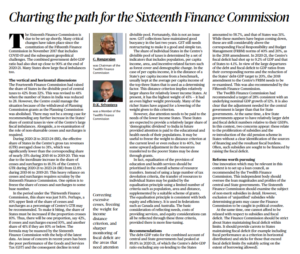
Context
- The Sixteenth Finance Commission faces critical challenges given the changes since the constitution of the Fifteenth Finance Commission in 2017, including the impact of COVID-19 and geopolitical complexities.
- The combined government debt GDP ratio has risen to nearly 90%, with many States showing significant fiscal imbalances. The allocation of central taxes to States increased in the past, but due to the excessive reliance on cesses and surcharges, the effective share of States has decreased.
- To address these issues, the Commission must re-examine the role of cesses and surcharges, consider freezing their share at a base number, and prioritize equalization principles in resource transfers.
- Additionally, the Commission should focus on restructuring the Goods and Services Tax (GST) and reassess the Fiscal Responsibility and Budget Management (FRBM) norms to ensure fiscal sustainability for both the central and State governments.
Share of States in Divisible Pool of Central Taxes:
- The Fourteenth Finance Commission had raised the share of States to 42% from 32% (revised to 41% when the number of States reduced to 28).
- Due to a rise in cesses and surcharges, the effective share of States in the Centre’s gross tax revenues (GTR) averaged close to 31%, significantly lower than the previous 35%.
- The Sixteenth Finance Commission should consider freezing the share of cesses and surcharges at a base number and recommend an upper limit of 10% of Centre’s GTR. If it exceeds 10%, the share of States should be increased accordingly.
Goods and Services Tax (GST):
- GST collections have maintained good buoyancy in recent years, but restructuring is required to make it a better and simpler tax.
Criteria for Determining Share of Individual States in Divisible Pool:
- The share of individual States is determined by indicators including population, per capita income, area, and incentive-related factors.
- The weight given to the distance criterion (per capita income compared to the average per capita income of the top three States) is currently 45%. Richer States seek a lower weight.
- The weight to the distance criterion may be frozen at the current level or reduced to 40%. Additional resources can be transferred to poorer States through grants to ensure equity.
Resource Transfers to States:
- Instead of using numerous tax devolution criteria, the transfer of resources should be guided by the equalisation principle, using a limited number of criteria such as population, area, and distance, along with suitable grants.
- Equalisation principle ensures equity and efficiency and is used in federations like Canada and Australia.
Fiscal Responsibility and Budget Management (FRBM) Norms:
- The combined debt-GDP ratio of central and State governments had peaked at 89.8% in 2020-21, well above the 40% and 20% norms set in the 2018 amendment.
- The Centre’s fiscal deficit was 9.2% of GDP, and States’ fiscal deficit was 4.1% in 2020-21.
- The 2018 amendment to the Centre’s FRBM needs re-examination, considering larger adjustments for the central government than for States.
Concerns Regarding Subsidies and Fiscal Deficit:
- Some State governments have relatively larger debt and fiscal deficit relative to their GSDPs.
- A loan council should be set up to oversee loan magnitudes and profiles of the central and State governments.
- The Sixteenth Finance Commission should examine non-merit subsidies in detail, while considering political sensitivities.
- The Commission should incentivize fiscal discipline among States and impose penalties for exceeding fiscal deficit limits.
Conclusion
The Sixteenth Finance Commission should carefully consider the economic challenges posed by COVID-19 and geopolitical issues.
It should re-examine the allocation of resources to States, address the issue of cesses and surcharges, and ensure fiscal discipline while meeting the needs of lower-income States.
Emphasizing the equalization principle and considering the restructuring of GST will further enhance efficiency and equity in resource allocation.
In an armed conflict, the war on women
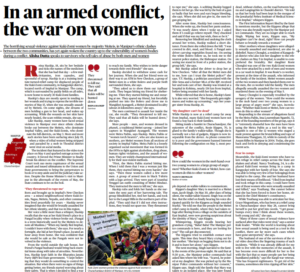
Introduction:
The Kangpokpi district in Manipur has turned into a relief camp for nearly 30 Kuki-Zomi families who have been displaced due to ethnic clashes between the Meiteis and Kuki-Zomis.
Reina Haokip, an 18-year-old victim, shares her harrowing experience of sexual assault and the traumatic aftermath.
Her story is one among many such incidents that have come to light since a video of tribal women being stripped and paraded by a mob went viral on social media.
Violence Breaks Out, Haokip’s Nightmarish Ordeal:
- Haokip’s peaceful life in Imphal’s New Checkon area was shattered when violence erupted between Meiteis and Kuki-Zomis. Fearing for her safety, she sought refuge at her Kuki friend’s place but was brutally assaulted by Meitei men.
- They threatened her life and subjected her to sexual violence before leaving her unconscious on a hillside.
Rosie Kipgen’s Tragic Tale:
- Rosie Kipgen’s daughter, Mary, married a Meitei man, Jacob Singh. After seeking refuge in a Meitei relief camp, Mary was taken away by the Manipur police commando and found dead later.
- The family alleges that Mary was also raped. Communication barriers and fear have left them unable to reach Singh.
Other Mothers in Disbelief:
- Nancy Chongloi lost her daughter Rosie Chongloi in an attack by a mob of Meitei men and women.
- The brutality of women handing over their own to be assaulted by men leaves them in shock and disbelief.
- The founding member of Meira Paibis, Ima Lourembam Ngambi, condemns the use of their group as a tool in the conflict.
Fear in Relief Camps:
- Kuki-Zomi women living in relief camps across Manipur are shaken and afraid. Nancy Touthang and Grace Ningombam share their fears of being sexually assaulted like the victims in the viral video.
- A senior Kuki leader believes many cases of sexual violence have gone unreported.
Conclusion:
The ethnic clashes in Manipur have exposed a disturbing pattern of sexual violence against Kuki-Zomi women.
Reina Haokip’s haunting experience highlights the scars within that persist long after physical wounds have healed.
The government, society, and organizations must take concrete steps to bring the perpetrators to justice, provide support to the survivors, and create a safe environment for all communities to coexist peacefully.
Ease of Doing Research
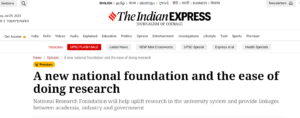
Context
The Union Cabinet has cleared a bill to establish the National Research Foundation (NRF) with a corpus of Rs 50,000 crore.
The NRF aims to increase research and development (R&D) spending in India, fostering a culture of inquiry, mentorship, and support in universities and research institutions.
Missions of the NRF:
- The NRF has three key missions:
- capacity building at universities and colleges,
- promoting cutting-edge research,
- supporting research for societal impact.
- It will fund competitive peer-reviewed grant proposals across all disciplines and institutions, including interdisciplinary research.
Faculty Mentorship and Professorships:
- The NRF will provide mentorship to faculty members and students through NRF professorships, offered to superannuated research faculty from premier institutions.
- This will help seed high-quality research in remote universities and colleges.
Promoting Cutting-Edge Research:
- The NRF will support curiosity-driven research, engage in international collaborations, and participate in mega-science projects to enhance research capacity in experimental sciences and engineering.
- It aims to increase India’s role in major national and global initiatives.
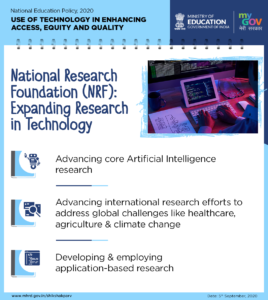
Inclusivity and Recognition:
- The NRF will recommend initiatives to increase the participation of women and other underrepresented groups in research.
- It will recognize outstanding research with awards and national seminars, facilitating coordination between researchers, government bodies, and industry partners.
NRF as a Think Tank:
The Foundation will function as a high-level think tank, coordinating and planning research and recommending key policy initiatives to the government regarding research, innovation, and education.
Ease of Doing Research:
- Researchers have expressed the need for “ease of doing research” in India, free from bureaucratic restrictions and financial policies.
- The NRF aims to bring out enlightened funding policies and procedures while ensuring accountability.
Administrative Structure and Governance:
- The NRF’s administrative structure is proposed to be modern, professional, and flexible.
- It will have a board of governors led by the President, Vice-President, and COO.
- The board will be accountable to the funding agencies and government.
Funding and Autonomy:
- Government support to the NRF will be provided as a block grant without specific sub-heads.
- The Foundation will aim to reach at least 0.1% of GDP in funding.
- The NRF will have administrative and financial autonomy to support good projects and determine its finances and governance.
Conclusion:
The NRF holds the promise of uplifting research in India’s university system, fostering cutting-edge research, and linking academia, industry, and government.
While the recent bill mentions a board of governors chaired by the Prime Minister and an executive council chaired by the Principal Scientific Adviser (PSA), the structure to handle the vast research expertise required remains to be seen.
Porous border and Manipur crisis
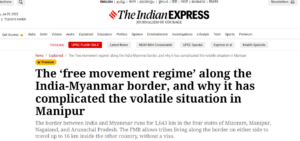
Context:
The ongoing ethnic conflict between the Meiteis and Kukis in Manipur is further aggravated by the issue of illegal migration of tribal Kuki-Chin people into India from Myanmar.
The Free Movement Regime (FMR) along the Indo-Myanmar Border (IMB) has come under scrutiny as it facilitates migration across the border without visas for tribes residing within a specified distance.
While the FMR was intended to promote people-to-people contact and local trade, it has inadvertently contributed to illegal immigration, drug trafficking, and gun running.
Background and Implementation of FMR:
- The FMR was established in 2018 as part of India’s Act East policy, allowing tribes living along the IMB to travel up to 16 km into each other’s countries without visas.
- This arrangement aimed to strengthen ties between India and Myanmar, particularly in the states of Mizoram, Manipur, Nagaland, and Arunachal Pradesh.
- The border’s history, drawn by the British in 1826 without consulting the local population, divided people of the same ethnicity and culture into two nations, leading to strong familial and ethnic ties across the border.

Positive Aspects of FMR:
- The FMR fostered people-to-people contact, facilitating local trade, and improving livelihoods in the region.
- Many villages in Manipur and Nagaland have homes that straddle the border, emphasizing the need for such an arrangement.
- It has provided access to better education, healthcare, and business opportunities in neighboring countries for border communities.
Challenges and Criticisms of FMR:
- The porous and unfenced border, coupled with the recent military coup in Myanmar, led to a significant influx of Kuki-Chin refugees into India, especially Manipur and Mizoram.
- While some locals have settled these refugees, others have accused village chiefs of illegally settling migrants, leading to deforestation and tensions with the government.
- Additionally, insurgent groups exploiting the FMR have established camps in Myanmar, engaging in drug trafficking and weapon smuggling, posing security risks for both nations.
Chief Minister’s Concerns:
- Manipur’s Chief Minister N Biren Singh has expressed concerns about illegal immigration and the potential security threats posed by unregulated movements along the border.
- He has called for cooperation from border communities to record the details of immigrants for the larger interests of the nation and the state.
Call for Better Regulation, Not Elimination:
- Experts agree that the FMR requires better regulation to address the challenges posed by illegal immigration and illicit activities.
- India suspended the FMR in September 2022 due to the escalating crisis in Myanmar and the influx of refugees.
- However, completely removing the FMR may not be desirable, as many locals have enjoyed the benefits of dual citizenship and access to education, trade, and medical facilities on both sides of the border.
The Middle Path:
- Experts propose a balanced approach to tackle the issue, acknowledging the socio-politico-economic dynamics in Myanmar and the demographics of the region.
- Complete fencing of the border is not considered the best option, as it may adversely affect communities with ancestral lands on both sides.
- Instead, a targeted approach to address illicit activities while preserving the positive aspects of the FMR is recommended.
Conclusion:
The Free Movement Regime along the Indo-Myanmar Border has been a subject of controversy, especially in the context of the ongoing ethnic conflict in Manipur.
While the FMR has facilitated people-to-people contact and local trade, it has also unintentionally allowed for illegal immigration, drug trafficking, and insurgent activities.
Striking a balance between addressing security concerns and preserving the benefits of the FMR will be crucial for promoting peace, stability, and development in the region.
Way towards Lab to Land and Land to Lab

Context:
On July 29th, NEP 2020 celebrates its third year of implementation, and it has already identified and addressed significant gaps in the previous educational systems.
The policy focuses on quality education from preschool to sixth standard, with an emphasis on using the mother tongue as the medium of instruction.
NEP also introduces several amendments to the higher education system, promoting skill development, hands-on experience, and flexibility for students.
Revolutionizing Education:
- NEP 2020 aims to reduce rote learning and promote rationalization of theory content.
- It advocates for open and digital learning platforms like SWAYAM and SWAYAM Prabha.
- The policy shifts towards practical-driven studies and eliminates curriculum redundancy to create a stress-free learning environment.
Capacity Building and Faculty Empowerment:
- Comprehensive capacity-building programs are introduced to familiarize teachers, school leaders, and administrators with NEP.
- The focus is on innovative teaching methodologies and the effective use of ICT tools to enhance the quality of education.
Futuristic Skills for Futuristic Jobs:
- NEP 2020 emphasizes skill development, catering to upcoming job growth in areas like education, agriculture, digital commerce, data science, and trades.
- The policy aims to develop analytical skills, talent management, leadership, and social influence.

Equity and Inclusion:
- NEP 2020 promotes equity and inclusion by empowering marginalized groups, including Divyangs, women, LGBTQs, SC/ST, and other marginalized communities.
- Various initiatives are taken to ensure equal access and opportunities for these groups.
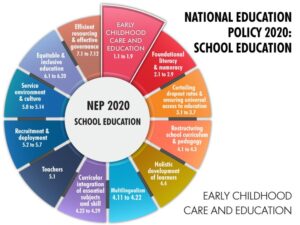
Internationalization and Research Promotion:
- NEP focuses on strengthening internationalization through collaborations with foreign universities and the establishment of digital e-universities.
- The policy also gives importance to research and development, showcasing India’s soft power and cultural diplomacy to the world.
Promoting Indian Knowledge System:
- NEP encourages the development of regional languages and Indian knowledge systems.
- AICTE has developed technical books in regional languages, and the Indian folk culture and orality are given importance in research areas.

Initiatives for Growth and Vishwaguru India:
- NEP takes various initiatives like the National Research Foundation, Atal Incubation Centres, and admission of international students to make India a Vishwaguru.
- It promotes physical, psychological, and emotional well-being, aiming to increase the Gross Enrollment Ratio in higher education.
Bridging the Gap:
- NEP 2020 emphasizes bridging the gap between school and higher education by promoting Early Childhood Care and Education (ECCE) and testing and assessment at various grades.
- It also introduces provisions for gender inclusion and setting up Kasturba Gandhi Balika Vidyalayas.
Initiatives for Education Improvement:
NEP introduces several initiatives like SARTHAQ, NIPUN, VIDYA PRAVESH, DIKSHA, NCFSE, and NISHTHA to improve the quality of education and teacher training.
Enhanced Portability and UGC’s Role:
- The National Credit Framework (NCrF) facilitates easy transfer of credits between programs and institutions.
- UGC has implemented various policies and portals to support the vision of NEP 2020.
PM Shri Narendra Modi as an Ambassador:
- Honorable Prime Minister Shri Narendra Modi actively promotes NEP 2020 and has addressed conclave events to disseminate the ideas behind the policy.
Conclusion:
In the three years since its implementation, NEP 2020 has made significant strides in transforming the educational landscape of India.
The policy focuses on equity, skill development, research, and inclusive growth, with an aim to make India a global leader in education.
By promoting quality education and fostering an environment of innovation and flexibility, NEP 2020 is driving positive changes in the education sector and paving the way for a bright future for the country.

